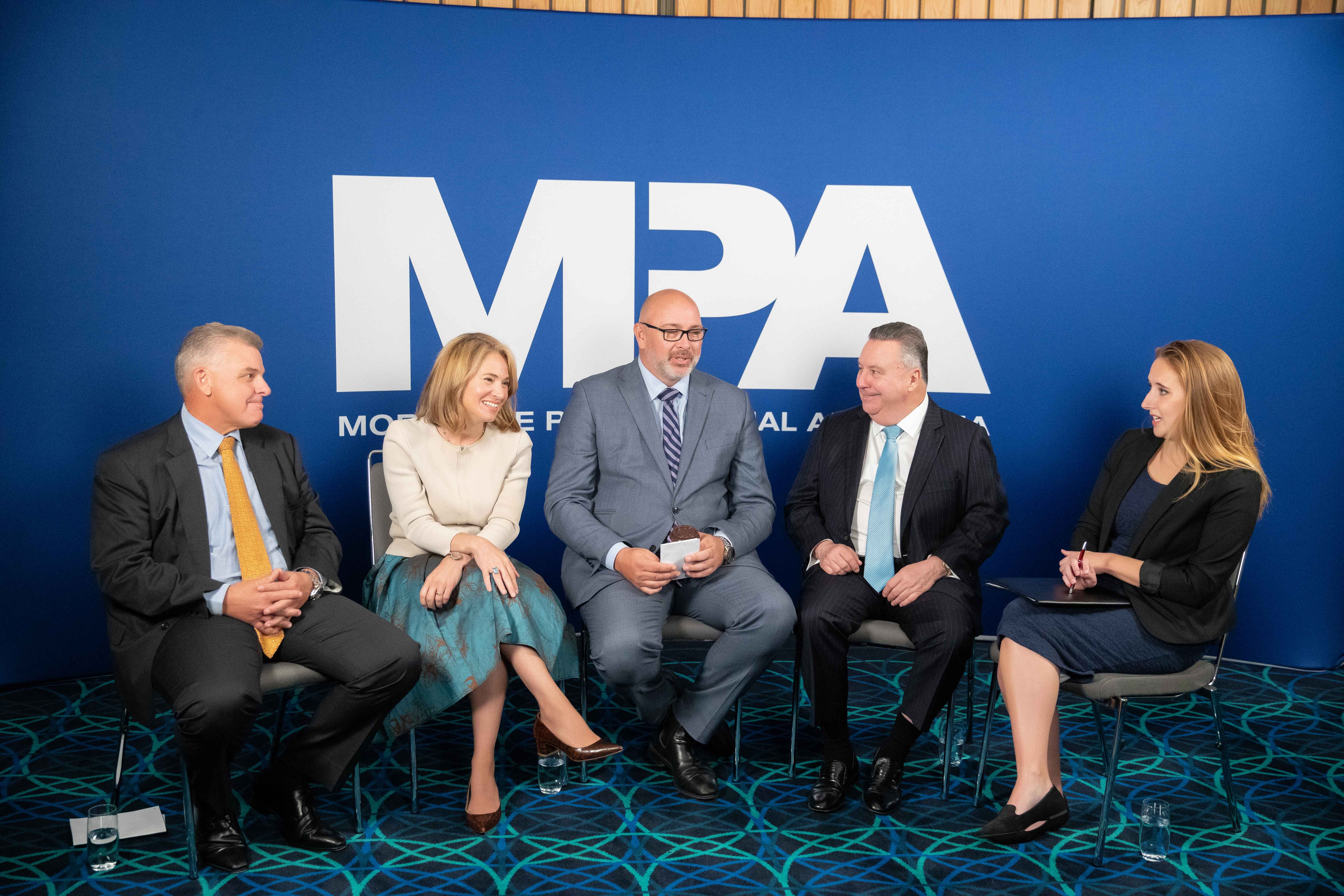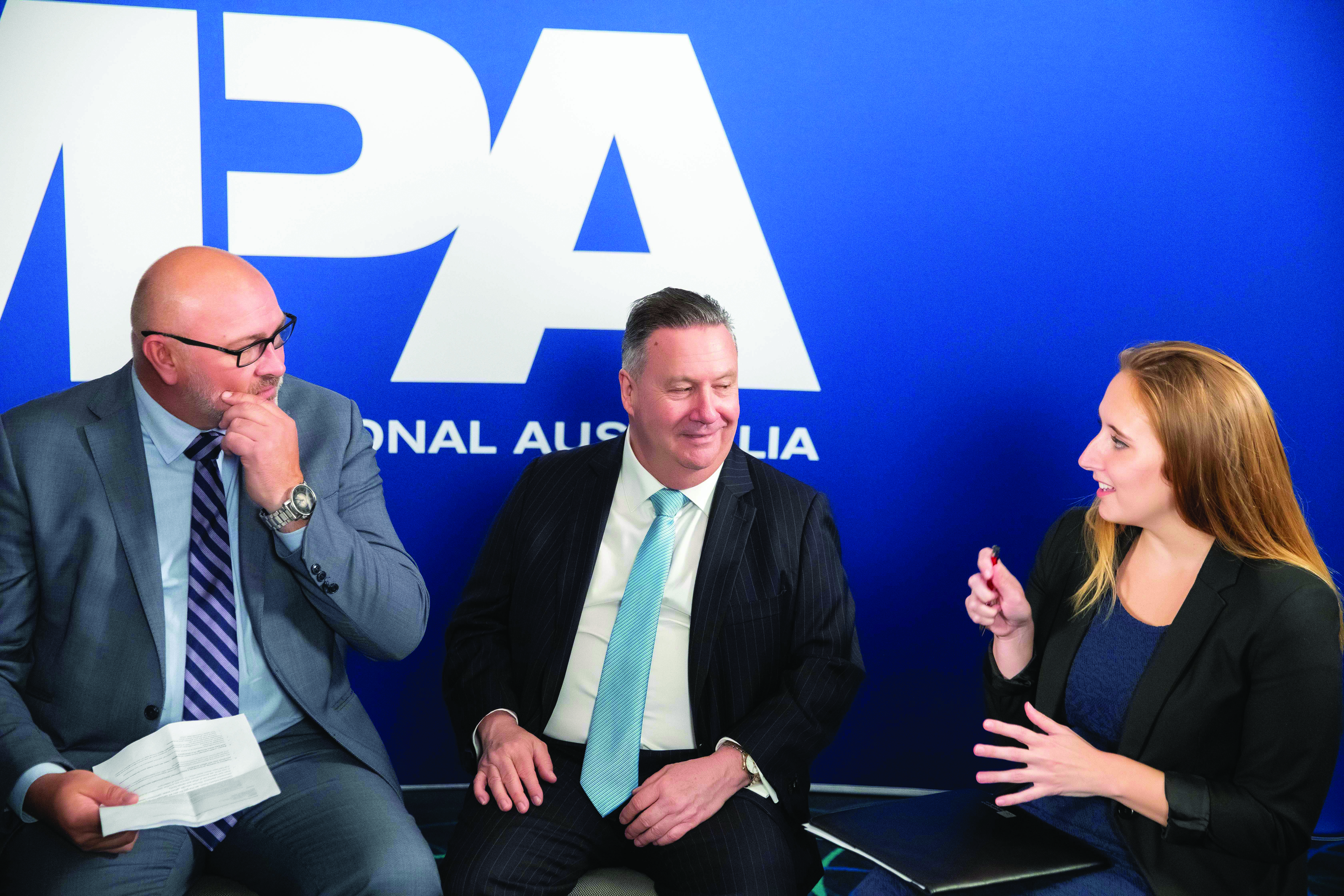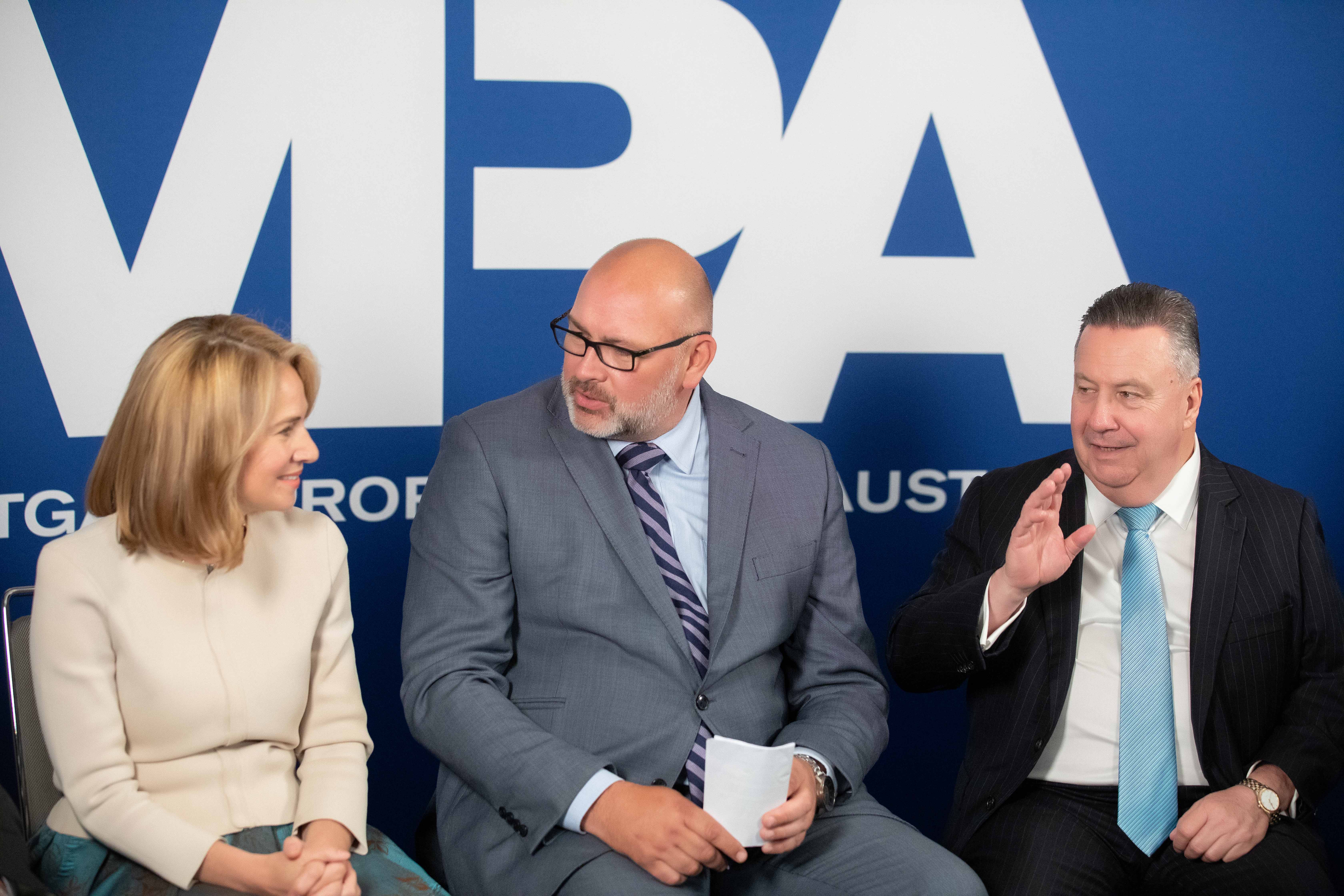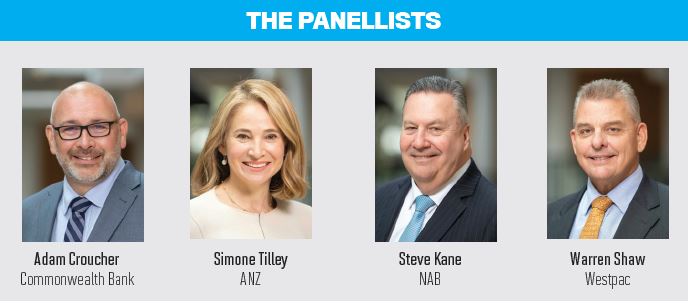The major banks took part in a live-streamed interview to discuss topics such as claw back, remuneration, and the best interests’ duty

Four representatives from the major banks took part in a live-streamed interview to discuss hot industry topics such as claw back, remuneration, turnaround times and the best interests’ duty
After postponing the MPA Major Banks Panel earlier this year thanks to the royal commission final report, four of the heads of third party finally gathered together at the Hyatt Regency in Sydney in October. The major banks have not had an easy time of it over the past 18 months. With the royal commission scrutinising their loan approvals, processes, treatment of customers and general greed, NPS scores have dropped and market share has been spreading to other lenders.
It was not just customers becoming distrustful of the banks; brokers too were not happy about the lack of support from the majors as well as the policy changes and tightened credit following the royal commission. But now that the royal commission is over and the industry is moving forward, the majors are here to prove they are still in the broker’s corner and are working to make things simpler for them. As one of the panellists said, their own credit assessors and internal teams have also had to struggle with changes so the banks are now working towards smoothing all the processes over.
The representatives from the majors were Simone Tilley, general manager of retail broker distribution at ANZ, Warren Shaw, head of broker distribution at Westpac, Steve Kane, general manager of broker distribution at NAB, and Adam Croucher, general manager of third party banking at Commonwealth Bank.
They provided clear and transparent insights into some of the internal workings of the banks and continued to acknowledge that they knew how hard it had been over the last year for the industry. They each showed clear willingness to consult with and work with the industry moving forward, particularly in terms of upcoming legislative changes such as the best interests’ duty and then later, the review into broker remuneration.
As well as asking questions prepared by MPA, brokers also sent in their own questions.
MPA would like to thank each of the panellists for taking time out of their busy schedules to attend and for answering those questions sent in by brokers. We would also like to thank brokers for taking the time to watch the panel and for being so engaged.
If you would like to watch the full session, you can do so at www.mpamagazine.com.au/tv
Q: How have each of you been supporting brokers over the past year?
The past 18 months have seen more than a few challenges in the mortgage broking industry and now that it is out the other side of the royal commission the banks are looking at how to address “the new normal”, as ANZ’s general manager of retail broker distribution Simone Tilley put it.
Working closely with brokers to “restore equilibrium” has been a key priority for ANZ. Tilley says the bank has made a number of changes to better align the intent of policies and the impact they have. It has also listened to broker feedback and is focusing more on education.
“We’re now working towards fortnightly webinars and they’re going incredibly well,” she said. “We’ve had record attendances, so we’ll continue to keep that going. Really for us it’s been about striving to be more reliant and consistent.”
Recognising the value mortgage brokers provide to the market and borrowers, general manager of broker distribution Steve Kane said NAB had been “the bank behind the broker”. As well as running educational seminars and digital PD days, Kane made note of NAB’s involvement in the Combined Industry Forum (CIF).
“We’re really trying to ensure that the best possible outcomes both for the customer and for the broker are recognised,” he said.
“It’s important that we recognise that as an industry we’ve achieved an enormous amount that was not really possible had we not had that collaborative approach and I think the bank has played an integral role as would my colleagues here in making sure we did that.”
Part of Westpac’s advocacy of the industry involves “myth-busting” and spreading what brokers do, how they do it and the quality of what they do, said head of broker distribution Warren Shaw.
He also pointed to the banks having the opportunity during regulatory engagement to discuss broker-originated loans and address the issues of the perceived difference in size and lengths of loans originated through different channels.
Commonwealth Bank’s general manager of third party banking Adam Croucher said education and training had been the bank’s “key mantra”. With more than 41% of new home loans now originated through brokers, Croucher said the commitment will continue to make brokers’ lives easier and improve customer outcomes.
“Whether it be our professional development days or our e-learnings we’re doing around particular topics, we’ll continue to invest in the education and training,” he said. “We see that as a real pillar and a platform for our business to strengthen our relationships with our broker partners.”
Croucher also said the bank would be using technology to ensure a streamlined process and that the broker is in the driver’s seat along the entire journey.

Q: In our Brokers on Banks survey this year, brokers said turnaround times were their top priority, but that they had worsened. Why is that and what are you doing to help with this?
Brokers have commented over the past two years that turnaround times have been becoming increasingly worse. In MPA’s Brokers on Banks survey this year, 52% of brokers said banks’ turnaround times had worsened in the past 12 months.
Shaw said he understood that brokers wanted to provide certainty to their customers as quickly as possible, recognising “brokers have got competition just like banks do”.
The period of constant legislation change means that brokers have had to deal with different policy approaches from different partners and Shaw admitted they had seen a lengthening in servicing times but they had recently been on top of that.
When change does have to happen, Westpac tries to keep brokers ahead of it. “We try to signal change as far ahead of it happening as we can, but sometimes we have some external factors at play that don’t allow us to put the lead time in,” he said.
“We acknowledge we do have to get better at that; we need to be more agile about our change management and prepare brokers better for big change that’s going to impact how they work with their customers.”
Croucher agreed the complexity of lending had increased over the past 12 months, saying there was “no doubt” there was more verification for them to meet their NCCP requirements.
At Commonwealth, the bank has heavily invested in its end-to-end process and added an extra 60 to 70 credit officers to ensure that as the complexity increased it has been able to upskill people so that as with Westpac, they can get any decisions to brokers as soon as possible.
“We have been really focused on being consistent with that and we will continue to put our resources in that avenue to make sure that once again it leads into a good customer outcome,” he said.
With almost 60% of mortgages written through mortgage brokers, Kane said, it is only natural there would be increased oversight and scrutiny. At NAB, the bank is spending the time upskilling and training staff and ensuring it has the right technology to provide the best service to brokers and customers.
“At the end of the day there’s a customer at the end of every transaction and that customer has to be given priority over everything,” he said.
Kane also acknowledged that there has been some cultural change and the banks have asked brokers to do things di erently. At NAB they have mandated a number of documents, but he said all this does is give the customers a better outcome, streamlining the process and enabling the bank to answer questions and keep brokers up to date with transactions.
“It’s not perfect, it still needs a lot of work, but we need to make sure our office is up to scratch as well as helping the brokers understand that the environment has changed, the scrutiny is not going to go away and we need to really make sure we work together to drive a good customer outcome,” he said.
Accepting that turnaround times were important to brokers, but conceding that the banks had had a challenging year, Tilley said that ANZ was working to get back to two-to three-day sustainable SLAs.
She added that even the assessors had gone through the same industry change and complexity, but that “what gets focus gets results” and this was a huge focus for ANZ.
“We’re empowering our assessors to m ake balanced judgmental decisions as they once did and we’re encouraging them to pick up the phone so they are being customercentric,” she said.
ake balanced judgmental decisions as they once did and we’re encouraging them to pick up the phone so they are being customercentric,” she said.
Another focus for ANZ was driving qualitative file reviews. “We understand we’re the only one in the market doing that and that’s to assist our brokers from a qualitative perspective,” she added.
“So they’re available to contract rework and get that fi rst touch decisioning and we’re really working together in partnership in that regard.”
Q: Treasury is looking at including a best interest duty principle into the NCCP. How do you think this will affect brokers?
Brokers had also texted into the live panel asking about the banks’ thoughts on the best interests’ duty and whether best interests was really the same as best price. ASIC published a report at the end of August which said that customers who used a mortgage broker expected them to find the ‘best’ home loan.
The same report then went on to say that one in five consumers felt they could have found a better interest rate, or they were not sure if they had a good interest rate.
Kane said brokers already put their customers’ interests first, so bringing in a duty would not mean brokers suddenly changing their behaviour. The one thing the industry does have to ensure, he said, are the operational activities like note-taking and keeping records of the entire transaction.
Regarding whether best interest is best price he said there were many facets to a loan. “Right from the fact of getting the approval from a loan, the type of product, the circumstances of the individual borrower,” he said.
“It’s about the holistic approach of providing a number of options that will meet the needs of the customer but it’s about recording those needs, understanding those needs and making sure that is looked after as the primary function of the relationship between the customer and the broker.”
Tilley agreed that brokers are already putting their customers’ interests first, but that legislation would ensure a single standard across the entire industry. This may mean that brokers who do not prioritise their customers’ interests drop out.
“If we see a small fallout at the bottom end where people aren’t prepared to accept the higher standards, that may not be a bad thing for the industry,” Tilley said. “I think the majority of brokers now are already doing it [but] it’s having a unified way about how the information is captured and systematised and evidenced.”
Shaw echoed the comments from Kane and Tilley, saying he supported the introduction of the duty because it will provide a more consistent protection for all consumers.
“I think we do need this duty and after the legislation is finalised there should be an opportunity to talk through what meeting the duty looks like,” Shaw said. “There’s some concern about meeting the duty because it is a principle-based obligation as it’s currently drafted so I’m sure we’ll get the opportunity to work through that.”

Praising the work of the Combined Industry Forum, Croucher said it was a real testament to the industry coming together to ensure it was in the driver’s seat. He also agreed with Kane’s comments about the loan being made up of a number of facets instead of price and this is where the industry’s input into the legislation is important.
“We’ll continue to work during the consultation period and beyond which we’re into now to make sure we have a strong thriving industry which is well protected to give great customer outcomes,” he said.
Q: Brokers have just gained a record market share – what do you think is the future of mortgage broking?
The MFAA’s latest Industry Intelligence Service reported that the proportion of home loans written by mortgage brokers reached 59.7% for the period 1 October 2018 to 31 March 2019.
Kane said he expects to see the broker’s role continue to expand as the trusted adviser of the customer and that that will expand to a holistic relationship in the types of products and services brokers offer.
In this way, the broker’s relationship with the customer will be longer, rather than just single transactions.
“From our perspective we’ve got a strong focus on small business, a strong focus on business banking and a strong focus to enable those brokers to offer more services than just a mortgage,” Kane said.
“Education and training, lifting the bar, making sure you’re adopting the new standards and putting into your business best business practices to ensure you’re always delivering to the customer’s needs will really see the broker channel continue to expand.”
The growing role of artificial intelligence, robotics and digital disruption will play a huge role in the future with respect to processing, said Tilley, but brokers still have a place.
“We all love the need for speed and so do our customers,” she said. “But I think for complex transactions and big decisions I think people are still going to want to deal with people. And this business has been based on an incredible strong relationship model being successful over time.”
Shaw was also positive about the future of brokers: “We think the future for brokers is really bright,” he said.
The figures from the MFAA and Westpac’s own research shows consumers can often be confused by the home loan process and brokers are uniquely placed with independence to provide that “navigation service”.
“I think as it becomes more complicated and as you bring in digitisation and AI etc, the broker’s going to have a huge role to play,” he said.
With increasing flows of broker-originated loans going through to Commonwealth Bank, Croucher also sees a period of growth for the channel, but he also sees a period of consolidation. “Brokers offering the choice and customers having the ability to make that choice is great for the industry and the longevity of the mortgage business in Australia,” he said.
“As we get into the industry leading some of the changes, the legislative requirements we’re going to get into, there will be a consolidation period. I think we’ve got nearly 11,000 brokers accredited with us and I see that there will be over the next period a level of consolidation and some growth in businesses as they really arm themselves for the challenges ahead.”
Q: As we prepare for the review in 2022 on mortgage broker commissions, where do you stand on broker commission and how will you be involved in that review?
While the federal election this year p rovided some relief to mortgage brokers, the coalition has committed to a review in 2022 to look at the impact on changing broker remuneration. Moving forward, brokers are keen to know how the major banks will support them as that review comes into play.
rovided some relief to mortgage brokers, the coalition has committed to a review in 2022 to look at the impact on changing broker remuneration. Moving forward, brokers are keen to know how the major banks will support them as that review comes into play.
Tilley acknowledged the complexity of the past 12 months and wanted to stress how important it was for brokers to have the right economic value in their remuneration model. Joining other banks and industry players in the CIF was one of the ways they were listening to “all the voices around the table” and Tilley herself represents ANZ Retail Broker on the Australian Banking Association.
“A tremendous amount of effort has been invested to make sure we’re doing the right thing for all industry participants, knowing very well that brokers deserve the right and fair economic value for what they do and what they bring to the bank,” she said.
Before the review, however, Shaw said it was important to remember the “here and now” and ensure that broker remuneration remains intact ahead of the review. As the review gets closer, he said the banks will then be ready to provide data on loan sizes and tenure to feed into the review.
“An enormous amount of work’s been going on and people in the industry representing brokers are alive to the potential issues,” he said. “Brokers should have confidence that they have a strong voice about protecting their income; brokers need to be paid for what they do - and reasonably paid - and undermining their revenue proposition unnecessarily is at the front of all of our minds.”
Kane agreed with Shaw and said it was important now to remove some of the complexity brought about over the past year with regards to the differences in the drawn downs.
That way, he said, when it comes to the review there will be more certainty and will reflect more than just what remuneration is, but it will reflect the advancement of the broker industry to ensure good customer outcomes.
“It’ll be reviewed around the basis of: have these measures we’ve put in place worked and improved the outcome for customers? Has there been any detriment? Has there been any conflict?” he said.
“I think that providing we continue to lift the bar and everyone does what they need to do to put the customer at the centre of everything, it will be a much better received review if we’ve done those things.”
Praising how proactive the industry had been around remuneration, Croucher looked at the number of things already addressed since the ASIC and Sedgwick Reviews and the royal commission, such as volume-based bonuses.
He added that as part of the CIF, Commonwealth Bank would continue to work to ensure fair and equitable pay for brokers.
“[The] Combined Industry Forum has really taken such a strong lead in this process. For the protection of the industry and brokers we see it as a very important part during any consultation; we feel that we’ve got our seat on the table and delivering our thoughts and process,” he said.
Q: How do you communicate with brokers when there are diff erences or changes made to expense verification?
With all the changes of the last year and different lenders taking different stances, it is important that brokers keep up to date so they can ensure the best outcomes for their customers.
Croucher said that Commonwealth Bank uses its broker platform, education and training days, digital online e-learning modules and face-to-face meetings to ensure brokers are on top of updates.
“We make sure brokers are in the driver’s seat to understand the changes,” he said. “We have many different forms of how we keep our brokers up to date with any changes and as you can imagine there’s been a fair few this year.”
Tilley agreed that the way ANZ shares information was important. The major bank issues Broker News once a fortnight to detail both process and policy changes; when more complex changes are introduced the bank will complement that with a webinar.
She also notes the more personal interactions ANZ has with brokers, such as coffee clusters around the country to encourage discussion.
“Often when you get like-minded people together talking on a topic it helps iron out the creases and people’s understanding of certain things,” she said. “We generally take a multi-pronged approach to disseminating information so there’s improved clarity in the  marketplace at any given point in time.”
marketplace at any given point in time.”
Agreeing communication was important, Shaw said it needed to be consistent and slick so everyone gets the same message in the same way, adding that BDMs were critical for on-the-ground delivery.
Westpac places a heavy focus on its BDMs and ensures it has adequate and responsive BDM capacity because “nothing is more frustrating for a broker than not being able to get support when they need it”.
\NAB has also used using multiple channels to communicate with its brokers, said Kane. As with Westpac, the group is focusing on its BDMs.
“One of the key things for us is looking at the role of the BDM in a more holistic fashion. Rather than it just being a relationship of the broker and firefighting really going out there and talking to them about the changes that they are going through and saying this is how it’s going to impact the application process, or whatever it happens to be, and then feeding all that information back so we can look at our processes,” he said.
Kane acknowledged that the changes have not been as smooth as they could have been, and it is up to the banks now to educate, train and provide the right systems.
“This has got all of our focus,” he added. “We don’t enjoy having longer times to process lending or going backwards and forwards. It’s not the desired outcome for anyone, and certainly not the customer, so it’s incumbent on all of us to do what we can and use the tools that have been brought forward to help us with it.”




